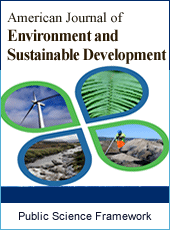American Journal of Environment and Sustainable Development
Articles Information
American Journal of Environment and Sustainable Development, Vol.4, No.1, Mar. 2019, Pub. Date: Mar. 5, 2019
Detection and Monitoring of Forest Fires in Dinder National Park, Sudan During 2010 - 2014 Using Remote Sensing Technology
Pages: 1-5 Views: 2062 Downloads: 721
[01]
Kawther Suliman Mohammed, Department of Forest Conservation and Protection, Faculty of Forestry, University of Khartoum, Shamat, Sudan.
[02]
Yousif Elnour Yagoub, Department of Forest Conservation and Protection, Faculty of Forestry, University of Khartoum, Shamat, Sudan.
[03]
Ahmed Ali Hassbelkreem Siddig, Department of Forest Conservation and Protection, Faculty of Forestry, University of Khartoum, Shamat, Sudan.
[04]
Omer Said Musa, Department of Forest Conservation and Protection, Faculty of Forestry, University of Khartoum, Shamat, Sudan.
[05]
Mohammed Elgamri AtaaElmanan Ibrahim, College of Forestry and Range Science, Sudan University of Science and Technology, Soba, Sudan.
[06]
Mohamed Mohamadein Abdullah Adam, Department of Forest Conservation and Protection, Faculty of Forestry, University of Khartoum, Shamat, Sudan.
This study aims to monitoring forest fire in Dinder National Park (DNP), Sudan, which is considered one of the richest biodiversity spots in the country. Being a typical savanna ecosystem, DNP is embedded in a highly fire-prone environment. The overall objectives of the study is to monitoring forest fire in DNP during 2010 - 2014, also to determine the burned areas by using application of remote sensing and GIS. As such, GIS layers (e.g. fire occurrences) were collected from NASA database and the climate data were collected from the global weather archive. The results showed that the fire occurred in 219.6, 419.6, 454.5, 372.4 and 375.1 ha, for 2010, 2011, 2012, 2013 and 2014, respectively (total area of DNP is about 1841.2 ha). During these four years, year 2012 witnessed a burning of about of 25% of the park area. Common causes of these forest fires in DNP include honey collection, farming and nomadic activities. We conclude that DNP authorities should focus on awareness-raising and extension programs to local communities to reduce the causes of these fire events but also to involve them in the management plan. Finally, this research provided insights about 5-years of fire patterns in DNP that can potentially be developed to a full wildfire database which can have substantial management implications in the future.
Forest Fire, Remote Sensing, Dinder National Park
[01]
Chazdon RL, Second G (2014). The promise of tropical forest regeneration in an age of deforestation. Chicago, IL: University of Chicago Press.
[02]
Puettmann KJ, Coates KD, Messier CA 92009). Managing for complexity. Washington, DC: Island Press.
[03]
Grainger A 92008). Difficulties in tracking the long-term global trend in tropical forest area. Proceedings of the National Academy of Sciences of the United States of America. 105: 818-823.
[04]
FAO. 2000. Comparison of forest area and forest area change estimates derived from FRA 1990 and FRA 2000. Forest Resources Assessment Working Paper 59.
[05]
Sasaki N, Putz FE (2009). Critical need for new definitions of “forest” and “forest degradation” in global climate change agreements. Conservation Letters. 2: 226-232 http://dx.doi.org/10.1111/j.1755-263X.2009.00067.x.
[06]
Brown S, Zarin D (2013). What does zero deforestation mean? Science. 342: 805-807. http://dx.doi.org/10.1126/science.1241277
[07]
Petersen R, Askenov D, Goldman E, Sargent S, Harris N, Manisha A, Esipova E, Shevade V, Loboda T (2016). Mapping tree plantations with multispectral imagery: Preliminary results for seven tropical countries. Technical Note. Washington, DC: World Resources Institute. http://www.wri.org/publication/mapping-treeplantations.
[08]
Shuang L, Christopher P (2012). Vegetation regrowth trends in post forest fire ecosystems across North America from 2000 to 2010. Natural Science. 4 (10): 755-770 http://dx.doi.org/10.4236/ns.2012.410100
[09]
Smith JK (2000). Wild land fire in ecosystems: effects of fire on fauna. Gen. Tech. Rep. RMRS- Ogden, UT: U.S. Department of Agriculture, Forest Service, Rocky Mountain Research Station. GTR-42, 1: 83 p. https://www.fs.fed.us/rm/pubs/rmrs_gtr042_1.pdf
[10]
Goetz SJ, Bunn AG, Fiske GJ, Houghton RA (2005). Satellite observed photosynthetic trends across boreal North America associated with climate and fire disturbance. Proceedings of the National Academy of Sciences. 03: 13521-13525. http://dx.doi.org/10.1073/pnas.0506179102
[11]
Brown ME, Pinzon JE, Tucker CJ (2004). New vegetation index data set to monitor global change. American Geophysical Union EOS Transactions. 85: 565-569. http://dx.doi.org/10.1029/2004EO520003
[12]
Kasischke ES, French NHF (1997). Constraints on using AVHRR composite index imagery to study patterns of vegetation cover in boreal forests. International Journal of Remote Sensing. 18: 2403-2426. http://dx.doi.org/10.1080/014311697217684
[13]
Justice CO, Giglio L, Korontzi S, Owens J, Morisette JT, Roy D, Descloitres J, Alleaume S, Petitcolin F, Kaufman Y (2002). The MODIS Fire Products. Remote Sensing of Environment. 83: 244-262. http://dx.doi.org/10.1016/S0034-4257(02)00076-7

ISSN Print: Pending
ISSN Online: Pending
Current Issue:
Vol. 6, Issue 4, December Submit a Manuscript Join Editorial Board Join Reviewer Team
ISSN Online: Pending
Current Issue:
Vol. 6, Issue 4, December Submit a Manuscript Join Editorial Board Join Reviewer Team
| About This Journal |
| All Issues |
| Open Access |
| Indexing |
| Payment Information |
| Author Guidelines |
| Review Process |
| Publication Ethics |
| Editorial Board |
| Peer Reviewers |


